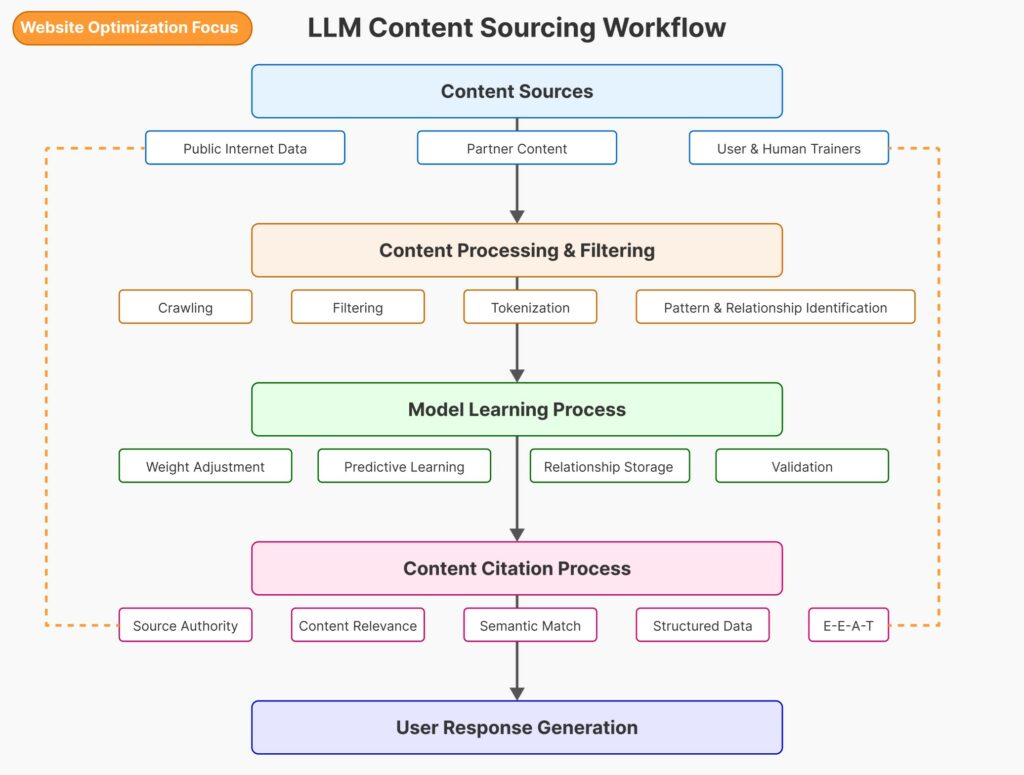Website Optimization for LLM Citation
Metadata Optimization
- Implement comprehensive schema.org markup for structured data across your business, services, and expertise
- Create detailed meta descriptions that accurately summarize page content
- Use descriptive, keyword-rich title tags that clearly indicate page topics
- Include proper canonical tags to avoid duplicate content issues
- Add appropriate Open Graph and Twitter card metadata for social sharing
- Ensure all content remains publicly accessible without paywalls or login requirements

Content Structure & Quality
- Use clear hierarchical heading structure (H1, H2, H3) following logical information architecture
- Include informative subheadings that summarize key points in each section
- Structure content with semantic HTML5 elements (article, section, aside, nav)
- Create content that answers specific questions comprehensively
- Include data tables with proper markup for structured information
- Maintain high information-to-word ratio for efficient knowledge transfer
- Build progressive knowledge structure from fundamental to advanced concepts
- Present information in multiple formats (text, tables, lists) to reinforce learning relationships
Semantic Relationships
- Create topic clusters with pillar pages and supporting content
- Use descriptive anchor text that indicates linked page content
- Build internal links between related content to establish topical authority
- Explicitly define relationships between concepts with clear statements
- Include concise definitions of key domain terms
- Structure content to showcase predictive patterns (cause-effect, problem-solution)
- Use semantic HTML enrichment beyond basic elements (time, mark, details, summary)
Technical SEO & Accessibility
- Ensure fast loading speeds and high Core Web Vitals scores
- Implement proper robots.txt configuration to guide crawler behavior
- Use HTTPS for security (LLMs prefer secure sources)
- Make your site mobile-friendly and responsive
- Ensure accessibility compliance (WCAG) to help with content parsing
- Maintain a flat site architecture where important pages are few clicks from homepage
- Create comprehensive sitemap.xml files to ensure all content is discoverable
- Implement machine-readable fact structures using schema.org types like ClaimReview
Trust & Authority Signals
- Include clear author information with credentials and expertise
- Cite authoritative external sources to support claims
- Display trust signals like testimonials, reviews, and certifications
- Regularly update content to maintain freshness and accuracy
- Provide transparent “About Us” and contact information
- Implement robust citation systems showing information sources
- Include explicit fact verification language (“research confirms,” “studies show”)
- Clearly mark content updates with dates to signal currency
- Add transparency statements about content origin and verification processes
Structured Data & FAQ Implementation
- Implement FAQ schema markup for question-answer pairs
- Create comprehensive FAQ sections addressing common queries in your field
- Structure answers in clear, concise formats that LLMs can easily extract
- Use consistent vocabulary and terminology throughout your site
- Include both broad and specific questions to capture different search intents
- Create knowledge graph connections through entity linking and references
Content Filtering Prevention
- Avoid content that might trigger filtering (spam patterns, excessive personal information)
- Respect privacy boundaries while remaining informative
- Include elements that signal legitimate content use (attributions, permissions)
- Create content with ethical considerations and standards clearly indicated
By implementing this comprehensive framework, you’ll significantly increase the likelihood that LLMs will recognize your content as valuable, authoritative, and worthy of citation. This approach aligns with how these systems actually learn from and evaluate web content, positioning your site as an ideal knowledge source.